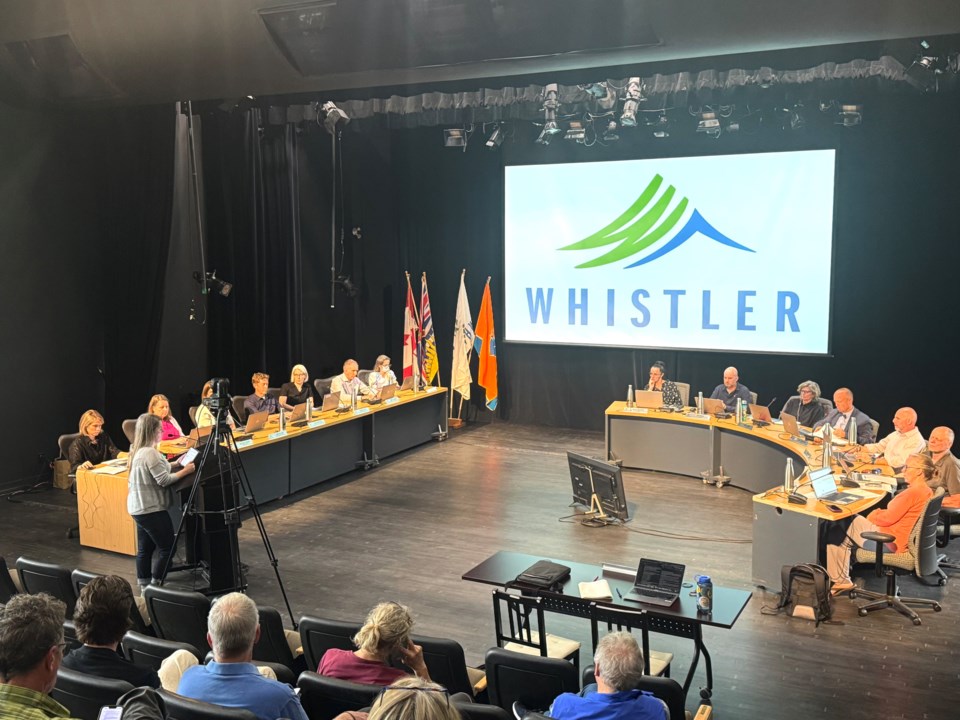Whistler council officially adopted its new Tree Protection Bylaw on June 24, despite a flurry of 11th-hour requests to delay the legislation in favour of broader consultation with local builders and landscape architects.
The bylaw—which aims to preserve Whistler’s urban canopy by regulating the removal of trees over 15 centimetres in diameter—passed unanimously, but not without heated debate over the consultation process, clarity of exemptions, and concern the delay could spark a rash of preemptive cutting.
“I won’t be supporting this [deferral],” said Councillor Jen Ford during deliberations. “It’s giving me anxiety just the length of time it’s taken us to have this conversation, knowing that there are people who are not afraid to cut down trees… I would rather this be more prohibitive than permissive in this case.”
The bylaw, known formally as Tree Protection Bylaw No. 2435, 2025, requires residents to apply for a permit to cut most trees within municipal boundaries, with some exceptions based on tree size, for FireSmart treatments, hazardous trees and existing development permits. It works in tandem with the also-adopted Environmental Protection Bylaw No. 2426, 2025.
While many residents and environmental advocates welcomed the move, some industry professionals said they felt blindsided.
“I’m a little frustrated that after being here last year asking for consultation and being involved, another one goes forward without that,” said a representative from the Landscape Association. “So it’s not so much about the exact bylaw itself… but please involve us next time and this time even more so.”
Landscape architect Crosland Doak echoed that concern: “I’m here to request to delay the fourth reading of this bylaw," he said. "I’m very excited that you guys look ahead … here’s a number of items that I think need a lot of work and that would give you better buy-in and probably better compliance.”
A lengthy letter from Doak submitted to council ahead of the meeting outlined more than a dozen proposed amendments. Others—including the Real Estate Association of Whistler and the Canadian Home Builders' Association of B.C.—backed his call for a pause.
But supporters warned any delay would only give property owners time to skirt the rules.
“Deferring adoption of this bylaw really invites preemptive tree-clearing,” said Claire Ruddy, former AWARE executive director. “Not bringing this bylaw into regulation, we will lose trees. We’ll lose them without process. We’ll lose them without transparency.”
AWARE board president John Rasmussen shared a recent example: over four consecutive nights in June, six mature pines were illegally topped on municipal land along the Valley Trail near Buckhorn Drive*—“in full knowledge that it was not legal,” he said.
“It speaks to changing attitudes in the community where view improvement is considered to trump any environmental or legal consequences of actions taken,” Rasmussen added. “We all have rights… that comes with a commensurate responsibility to protect.”
The bylaw also includes a new density minimum, though Coun. Cathy Jewett noted the rules could be “a little bit confusing” when intersecting with thresholds for significant trees, tree size and the number of removals.
Jewett also voiced concern over rising tree mortality caused by climate stress. Red trees caused by Western spruce budworm in Whistler are hard to miss, seemingly seen everywhere throughout the town. “I was absolutely shocked to see the change in the forest,” Jewett said, referencing the rapid reddening of forests in Whistler of late linked to spruce budworm defoliation (check back with Pique in the coming weeks for more on this issue).
Council ultimately rejected a proposed deferral to July 22 and instead passed a follow-up motion requiring staff to monitor implementation and return with an update—and potential amendments—within 12 months.
“I thought some letters were thoughtful,” said Mayor Jack Crompton. “I’m grateful that we get to consider them alongside a bylaw that will be implemented if this passes.”
Jewett said she initially supported deferring the bylaw but was reassured by staff’s willingness to monitor its rollout and report back. She acknowledged concerns around public consultation and explained recent changes to how council conducts its business—particularly by using committee of the whole meetings to review bylaws and rezonings in greater detail—may not have been clearly communicated to the public. While council had more time to review proposals in this format, Jewett said many residents may not realize items presented at committee of the whole have already been reviewed before they appear on the regular council agenda, leading to confusion about the consultation timeline.
“Sometimes communication is speaking and listening, and sometimes it just doesn’t land. In this case, it hasn’t landed with significant constituency groups,” said Coun. Ralph Forsyth.
Even so, Coun. Arthur De Jong noted the urgency of the situation. “With climate change, with accelerating summer temperatures, we’re going to see significant die-offs here,” he said. “The landscape work that we're going to have to do in order to try to subdue the increasing fire hazard and so forth, this is going to be very, very significant. So that's something that we need to be looking forward at."
Council passed the bylaw unanimously.
*An earlier version of this story incorrectly stated the incident occurred near Blackcomb Drive. It was in fact Buckhorn Drive. Further, former AWARE executive director Claire Ruddy was misidentified as Claire Wright. Pique regrets the errors.




